Fery
National Hazard
   
Posts: 990
Registered: 27-8-2019
Location: Czechoslovakia
Member Is Offline
|
|
CsICl4 caesium tetrachloroiodate
To 25 ml Erlenmeyer flask was added 7,0 g 35% HCl - approx 10% more than theoretically required 0,0600 mol (I usually weigh liquids instead of
measuring their volume) which was diluted with 3 ml of H2O (to minimize HCl loses during Cl2 gas evolution). To the diluted HCl was slowly added in
small portions 2,14 g (0,0100 mol) KIO3 during 10 minutes while whirling the flask in hand - fumehood required or working outside.
KIO3 + 6 HCl = KICl4 + Cl2 + 3 H2O
The flask was allowed to stand for half an hour to release more of Cl2 gas (eventually air could be bubbled through the solution using compressor of
vacuum). There was a precipitate visible which I presume was KIClO4 (I hope it was not unreacted KIO3 but who knows...) so I added 5 ml of H2O which
caused most of the precipitate to dissolve but complete dissolution was observed after slightly warming the reaction mixture over small ethanol burner
(approx 50 C, it was possible to held the flask in bare hand). Then it was allowed to cool down to room temperature at which it stayed clear so no
more precipitation/crystallization observed even after 2 hours.
1,68 g CsCl (0,0100 mol) was dissolved in 10 ml of H2O (well, 2 ml could be enough, I used a lot of water just to obtain as big crystals as possible)
which was added into the solution of KICl4 in the Erlenmeyer flask while whirling in hand together with rinsing the beaker 2 times with a little of
H2O. After 2 seconds small crystals started to form (in size of approx 1 mm) and in less than 1 minute the crystallization seemed to be completed.
Then the flask was closed with plastic foil and put into a fridge to 4 C overnight to continue crystallization as the mother liquor was still too deep
in color.
The crystals were filtered on sintered glass and air dried.
Perhaps better yield could be obtained using less H2O (not diluting HCl, dissolving CsCl in 2 ml of H2O).
I hope KIO3 fully reacted so there was no CsIO3 precipitate (solubility of CsIO3 in 100 ml of water: 1,08 g at 0 C, 2,21 g at 20 C)
CsICl4 is allegedly stable compound unlike unstable KICl4 which slowly releases ICl3.
woelen, if you read this, could you please post your method, I found you mentioned that you had prepared this compound:
https://www.sciencemadness.org/whisper/viewthread.php?tid=13...
| Quote: |
I have done quite a few syntheses of different chemicals (e.g. KBrO3, KIO3, KIO4, Na2TeO3, Na2MoO4, csicl4)
|
another route
CsI + 4 HCl + 4 HNO3 = CsICl4 + 4 H2O + 4 NO2
is here:
https://thepresentation.ru/uncategorized/moy-lyubimyy-sintez...
pictures:
reactants: HCl in flask, KIO3
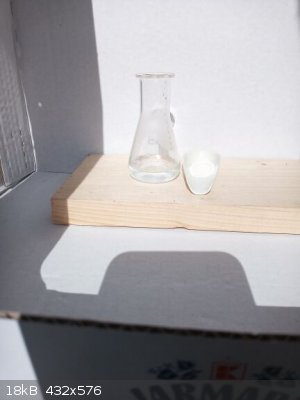
addition of KIO3 into HCl started, not yet Cl2 gas evolution observed
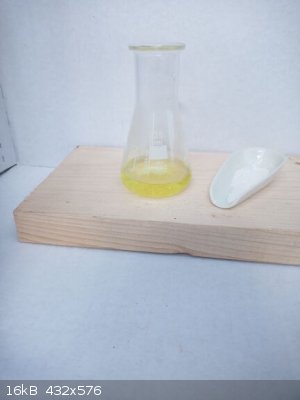
continuing addition of KIO3 into HCl, Cl2 gas evolution, whirling the flask in hand necessary (not visible on the image)
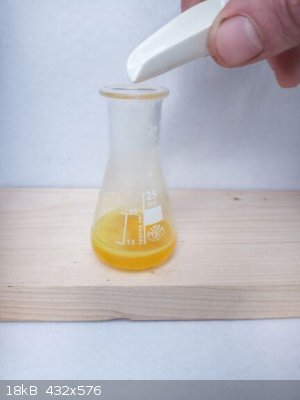
continuing addition of KIO3 into HCl, here Cl2 gas evolution well visible
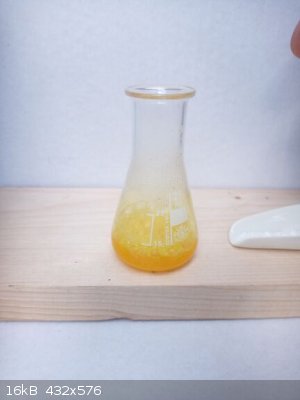
whole KIO3 already added into HCl, some precipitate visible, presuming KICl4
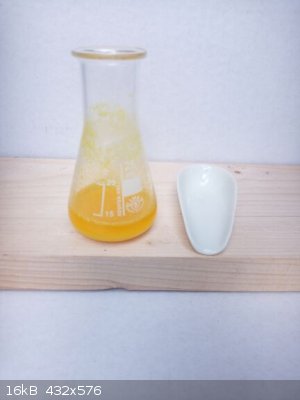
addition of 5 ml of H2O and slightly heating the flask to 50 C helped to dissolve everything so clear solution obtained, then it was allowed to cool
down to room temperature at which it stayed clear still after 2 hours (no precipitation / crystallization anymore)
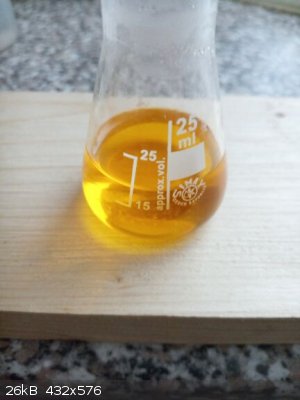
1,68 g CsCl dissolved in 10 ml H2O in 25 ml beaker (on the right side)

the solution of CsCl was added into the solution of KICl4 while whirling the flask in hand, crystallization started after 2 seconds, crystals size
approx 1 mm
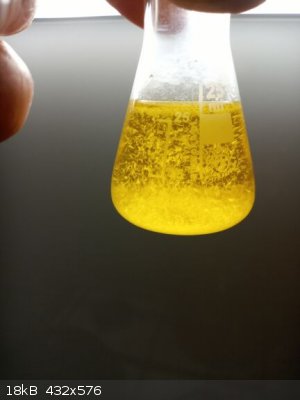
crystallization slowly proceeded during about 1 minute, then the flask was closed with plastic foil and put into a fridge to 4 C overnight for further
crystallization
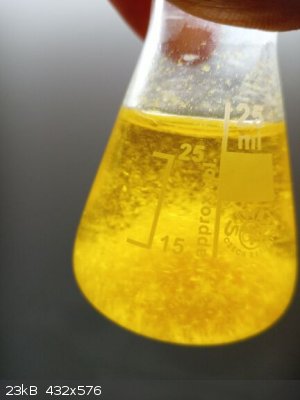
|
|
|
woelen
Super Administrator
        
Posts: 7976
Registered: 20-8-2005
Location: Netherlands
Member Is Offline
Mood: interested
|
|
The material you obtain in this way most likely is not pure CsICl4. I expect a lot of coprecipitated KICl4. It would be interesting to test this
material for the presence of K(+) ions.
I myself made CsICl4 from HIO3 and CsCl. First, I added HIO3 to conc. HCl and then I added concentrated solution of CsCl to the obtained yellow
solution. The solution, obtained in that way is pure CsICl4, no other metal ions are present.
Isolation of the CsICl4 is not that easy. On drying it tends to lose ICl3 and CsCl remains behind. What really works great is making N(CH3)4ICl4. That
salt is amazingly stable and also in contact with air, it does not lose ICl3.
|
|
|
Fery
National Hazard
   
Posts: 990
Registered: 27-8-2019
Location: Czechoslovakia
Member Is Offline
|
|
woelen thank you very much
I can let my product to stay for some time and determine possible weigh loss due to decomposition to CsCl + ICl3
determining K+ in large quantity of Cs+ could be tricky task in home lab
I tried to suppress KICl4 crystallization as much as possible by diluting the KICl4 solution, your method using HIO3 is the best way to go
|
|
|
Fery
National Hazard
   
Posts: 990
Registered: 27-8-2019
Location: Czechoslovakia
Member Is Offline
|
|
I added some excess of HCl and also let to release Cl2 for prolonged time as there is an equilibrium in the reaction so I hope the product is not
contaminated by CsIO3 too much
perhaps I should add more HCl, not only 10% excess
even HICl4 . 4 H2O crystallizes at low temperatures
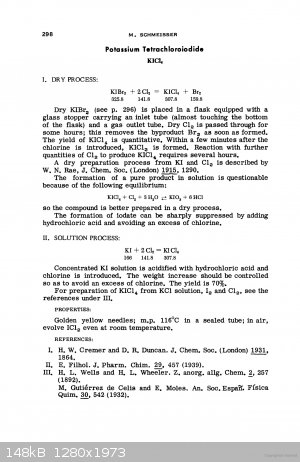 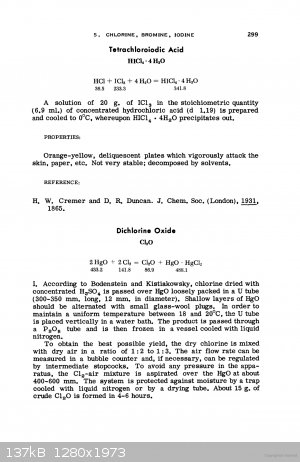
|
|
|
Fery
National Hazard
   
Posts: 990
Registered: 27-8-2019
Location: Czechoslovakia
Member Is Offline
|
|
as the yield was even less than miserable, I let the mother liquor to evaporate at room temperature for months since my initial post, it evaporated
very unwillingly from 25 ml to 7 ml yielding the beautiful crystal weighing 1,48 g
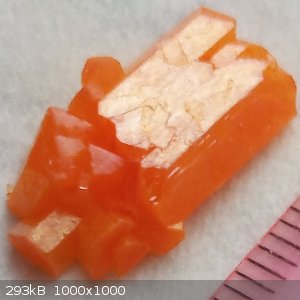 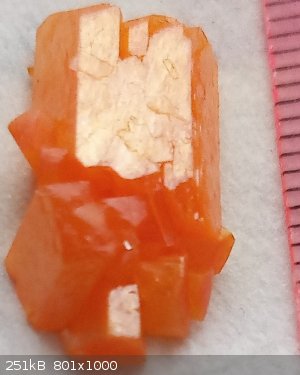 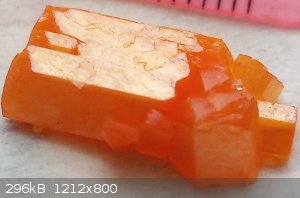  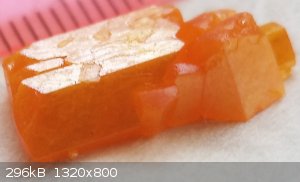 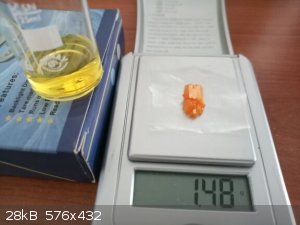
|
|
|
MadHatter
International Hazard
    
Posts: 1332
Registered: 9-7-2004
Location: Maine
Member Is Offline
Mood: Enjoying retirement
|
|
Crystal
Fery, that is a gorgeous looking crystal !
Have you verified the compound yet ?
From opening of NCIS New Orleans - It goes a BOOM ! BOOM ! BOOM ! MUHAHAHAHAHAHAHA !
|
|
|
DraconicAcid
International Hazard
    
Posts: 4278
Registered: 1-2-2013
Location: The tiniest college campus ever....
Member Is Offline
Mood: Semi-victorious.
|
|
That's an amazing crystal. I've been planning to make some of the tetraethylammonium salt one of these days- I should get around to it.
Please remember: "Filtrate" is not a verb.
Write up your lab reports the way your instructor wants them, not the way your ex-instructor wants them.
|
|
|
Fery
National Hazard
   
Posts: 990
Registered: 27-8-2019
Location: Czechoslovakia
Member Is Offline
|
|
Hi MadHatter, I was quite disappointed with the poor yield in May, so I let the mother liquor to evaporate, it did veeery slooowly (2,5 months from 25
ml to 7 ml in an open beaker at room temperature). Woelen pointed out that the product obtained this way could be contamined with K+ but I do not know
how to easily determine that, flame test wouldn't help here (would be easy for sodium, but not for small amounts of K in Cs). Another contamination
could be IO3-
DraconicAcid, pls post your crystals when done, this cation has quite large ionic radius.
|
|
|
DraconicAcid
International Hazard
    
Posts: 4278
Registered: 1-2-2013
Location: The tiniest college campus ever....
Member Is Offline
Mood: Semi-victorious.
|
|
My mistake, I've got tetramethylammonium, not tetraethyl.
I did get a nice little vial full of tetramethylammonium tetrachloroiodate, but no large crystals.
Please remember: "Filtrate" is not a verb.
Write up your lab reports the way your instructor wants them, not the way your ex-instructor wants them.
|
|
|